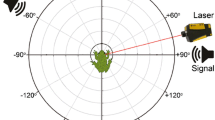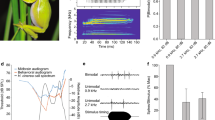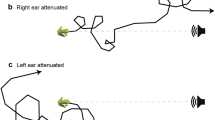Abstract
Frogs and toads are capable of producing calls at potentially damaging levels that exceed 110 dB SPL at 50 cm. Most frog species have internally coupled ears (ICE) in which the tympanic membranes (TyMs) communicate directly via the large, permanently open Eustachian tubes, resulting in an inherently directional asymmetrical pressure-difference receiver. One active mechanism for auditory sensitivity reduction involves the pressure increase during vocalization that distends the TyM, reducing its low-frequency airborne sound sensitivity. Moreover, if sounds generated by the vocal folds arrive at both surfaces of the TyM with nearly equal amplitudes and phases, the net motion of the eardrum would be greatly attenuated. Both of these processes appear to reduce the motion of the frog’s TyM during vocalizations. The implications of ICE in amphibians with respect to sound localizations are discussed, and the particularly interesting case of frogs that use ultrasound for communication yet exhibit exquisitely small localization jump errors is brought to light.




Similar content being viewed by others
References
Aertsen AMHJ, Vlaming MSMG, Eggermont JJ, Johannesma PIM (1986) Directional hearing in the grassfrog (Rana temporaria L.). II Acoustics and modeling of the auditory periphery. Hear Res 21:17–40
Bee MA, Cook JM, Love EK, O’Bryan LR, Pettitt BA, Schrode K, Vélez A (2010) Assessing acoustic signal variability and the potential for sexual selection and social recognition in boreal chorus frogs (Pseudacris maculata). Ethology 116:564–576
Benevides FL Jr, Mautz WJ (2014) Temporal and spectral characteristics of the male Eleutherodactylus coqui two-note vocalization in Hawaii. Bioacoustics 23:29–38
Bergevin C, Meenderink SWF, Van der Heijden M, Narins PM (2015) Slow dynamics of the amphibian tympanic membrane. In: Karavitaki KD, Corey DP (eds) Mechanics of hearing: protein to perception. American Institute of Physics, Melville, pp 060001-1–06001-5. doi:10.1063/1.4939356
Boistel R, Aubin T, Cloetens P, Peyrin F, Scotti T, Herzog P, Gerlach J, Pollet N, Aubry J-F (2013) How minute sooglossid frogs hear without a middle ear. Proc Natl Acad Sci 110:15360–15364
Brenowitz EA (1982) The active space of red-winged blackbird song. J Comp Physiol 147:511–522
Christensen-Dalsgaard J (2005) Directional hearing in non-mammalian tetrapods. In: Popper AN, Fay RR (eds) Sound source localization. Springer, New York, pp 67–123
Christensen-Dalsgaard J (2011) Vertebrate pressure-gradient receivers. Hear Res 273:37–45
Chung S-H, Pettigrew A, Anson M (1978) Dynamics of the amphibian middle ear. Nature 272:142–147
Ehret G, Tautz J, Schmitz B, Narins PM (1990) Hearing through the lungs: lung-eardrum transmission of sound in the frog Eleutherodactylus coqui. Naturwissenschaften 77:192–194
Ehret G, Keilwerth E, Kamada T (1994) The lung-eardrum pathway in three treefrog and four dendrobatid frog species: some properties of sound transmission. J Exp Biol 195:329–343
Feng AS (1980) Directional characteristics of the acoustic receiver of the leopard frog (Rana pipiens): a study of eighth nerve auditory responses. J Acoust Soc Am 68:1107–1114
Feng AS, Shofner WP (1981) Peripheral basis of sound localization in anurans. Acoustic preperties of the frog’s ear. Hear Res 5:201–216
Feng AS, Gerhardt HC, Capranica RR (1976) Sound localization behavior of the Green Treefrog (Hyla cinerea) and the Barking Treefrog (H. gratiosa). J Comp Physiol 107:241–252
Feng AS, Narins PM, Xu C-H, Lin W-Y, Yu Z-L, Qiu Q, Xu Z-M, Shen J-X (2006) Ultrasonic communication in frogs. Nature 440:333–336
Fletcher NH (1992) Acoustic systems in biology. Oxford University Press, New York
Fletcher NH, Thwaites S (1979) Physical models for the analysis of acoustical systems in biologhy. Q Rev Biophys 12:25–65
Gans C (1974) Biomechanics: an approach to vertebrate biology. Lippincott, Philadelphia
Gerhardt HC (1975) Sound pressure levels and radiation patterns of the vocalizations of some North American frogs and toads. J Comp Physiol 102:1–12
Gridi-Papp M, Feng AS, Shen J-X, Yu Z-L, Narins PM (2008) Active control of ultrasonic hearing in frogs. PNAS 105:11013–11018
Griffin DR (1976) The audibility of frog choruses to migrating birds. Anim Behav 24:421–427
Ho CCK, Narins PM (2006) Directionality of pressure-difference receiver ears in the northern leopard frog, Rana pipiens pipiens. J Comp Physiol 192:417–429
Jørgensen MB, Christensen-Dalsgaard J (1997) Directionality of auditory nerve fiber responses to pure tone stimuli in the grassfrog Rana temporaria. II. Spike timing. J Comp Physiol A 180:503–511
Jørgensen M, Gerhardt HC (1991) Directional hearing in the gray treefrog Hyla versicolor: eardrum vibrations and phonotaxis. J Comp Physiol A 169:177–183
Michelsen A, Jørgensen M, Christensen-Dalsgaard J, Capranica RR (1986) Directional hearing of awake, unrestrained treefrogs. Naturwissenschaften 73:682–683
Narins PM (1992) Reduction of tympanic membrane displacement during vocalization of the arboreal frog, Eleutherodactylus coqui. J Acoust Soc Am 91:3551–3557
Narins PM, Capranica RR (1978) Communicative significance of the two-note call of the treefrog Eleutherodactylus coqui. J Comp Physiol 127:1–9
Narins PM, Feng AS (2007) Hearing and sound communication in amphibians: prologue and prognostication. In: Narins PM, Feng AS, Fay RR, Popper AN (eds) Hearing and sound communication in amphibians. Springer, Heidelberg, pp 1–11
Narins PM, Hurley DD (1982) The relationship between call intensity and function in the Puerto Rican Coqui (Anura: Leptodactylidae). Herpetologica 38:287–295
Narins PM, Ehret G, Tautz J (1988) Accessory pathway for sound transfer in a neotropical frog. PNAS 85:1508–1512
Narins PM, Feng AS, Schnitzler H-U, Denzinger A, Suthers RA, Lin W, Xu C-H (2004) Old World frog and bird vocalizations contain prominent ultrasonic harmonics. J Acoust Soc Am 115:910–913
Narins PM, Feng AS, Shen J-X (2007) Frogs communicate with ultrasound in noisy environments. In: Kollmeier B, Klump G, Hohmann V, Langemann U, Mauermann M, Uppenkamp S, Verhey J (eds) Hearing—from sensory processing to perception. Springer, Heidelberg, pp 185–190
Narins PM, Wilson M, Mann D (2014) Ultrasound detection in fishes and frogs: discovery and mechanisms. In: Köppl C, Manley GA, Popper AN, Fay RR (eds) Insights from comparative hearing research. Springer, Heidelberg, pp 133–156
O’Neill EM, Beard KH (2011) Clinal variation in calls of native and introduced populations of Eleurodactylus coqui. Copeia 1:18–28
Palmer AR, Pinder AC (1984) The directionality of the frog ear described by a mechanical model. J Theor Biol 110:205–215
Passmore NI (1981) Sound levels of mating calls of some African frogs. Herpetologica 37:166–171
Passmore NI, Carruthers VC (1979) South African frogs. Witwatersrand University Press, Johannesburg
Passmore NI, Capranica RR, Telford SR, Bishop PJ (1984) Phonotaxis in ther painted reed frog (Hyperolius marmorata). The localization of elevated sound sources. J Comp Physiol 154:189–197
Penna M, Solis R (1998) Frog call intensities and sound propagation in the South American temperate forest region. Behav Ecol Sociobiol 42:371–381
Pinder AC, Palmer AR (1983) Mechanical properties of the frog ear: vibration measurements under free- and closed field acoustic conditions. Proc R Soc Lond B 219:371–396
Purgue AP (1997) Tympanic sound radiation in the bullfrog Rana catesbeiana. J Comp Physiol 181:438–445
Purgue AP, Narins PM (2000) Mechanics of the inner ear of the bullfrog (Rana catesbeiana): the contact membranes and the periotic canal. J Comp Physiol 186:481–488
Schwartz JJ (1987) The function of call alternation in anuran amphibians: a test of three hypotheses. Evolution 41:461–471
Shen J-X, Feng A-S, Xu Z-M, Yu Z-L, Arch VS, Yu X-J, Narins PM (2008) Ultrasonic frogs show hyperacute phonotaxis to female courtship calls. Nature 453:914–916
Shen J-X, Xu Z-M, Yu Z-L, Wang S, Zheng D-Z, Fan S-C (2011) Ultrasonic frogs show extraordinary sex differences in auditory frequency sensitivity. Nat Commun 2:342. doi:10.1038/ncomms1339
Shofner WP (2015) Acoustic analysis of the frequency-dependent coupling between the frog’s ears (L). J Acoust Soc Am 138:1623–1626
Sun JWC, Narins PM (2005) Anthropogenic sounds differentially affect amphibian call rate. Biol Conserv 121:419–427
Vlaming MSMG, Aertsen AMHJ, Epping WJM (1984) Directional hearing in the grass frog (Rana temporaria L.): I. Mechanical vibration of tympanic membrane. Hear Res 14:191–201
Vossen C, Christensen-Dalsgaard J, van Hemmen JL (2010) Analytical model of internally coupled ears. J Acoust Soc Am 128:909–918
Wang J, Ludwig T, Narins PM (1996) Spatial and spectral dependence of the auditory periphery in the northern leopard frog. J Comp Physiol A 178:159–172
Wilczynski W, Resler C, Capranica RR (1987) Tympanic and extratympanic sound transmission in the leopard frog. J Comp Physiol A 161:659–669
Yager DD (1992) Underwater acoustic communication in the African pipid frog Xenopus borealis. Bioacoustics 4:1–24
Author information
Authors and Affiliations
Corresponding author
Additional information
This article belongs to a Special Issue on Internally Coupled Ears (ICE).
Rights and permissions
About this article
Cite this article
Narins, P.M. ICE on the road to auditory sensitivity reduction and sound localization in the frog. Biol Cybern 110, 263–270 (2016). https://doi.org/10.1007/s00422-016-0700-z
Received:
Accepted:
Published:
Issue Date:
DOI: https://doi.org/10.1007/s00422-016-0700-z




